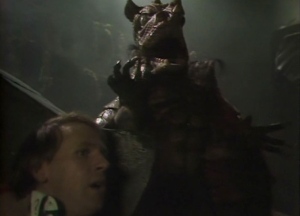It’s hard to believe that, just two seasons ago, I was watching the Rani in a wig and a space bus full of rock ‘n’ roll tourists. Somebody obviously woke up and realised Doctor Who needed to be a bit more serious and sophisticated, and The Curse of Fenric is the high point so far. Well, it’s as sophisticated as a TV show can be when it features vampires, ancient viking curses and a man who travels in a police box, while still being accessible family viewing.

Dr. Judson and his ULTIMA machine are clearly based on Alan Turing and the Enigma machine. I’m not sure the Enigma machine ran on poisonous green gooey artifacts, though.
The cast is mostly terrific. Nicholas Parsons is great as the reverend struggling with his faith amidst the violent backdrop of World War II. Alfred Lynch plays Millington, a slightly unhinged naval commander, and although he comes across as a bit “Poundland Gary Oldman”, it’s a classy performance anyway. Some of the extras are cringeworthy, but Ace is definitely improving and her scenes with the Doctor are, hands down, the best so far.

In a sci-fi twist on a legend, it’s not the crucifix that keeps vampires away, it’s the psychic barrier caused by unwavering faith. Sure, why not?
There’s some solid drama and emotion here. It’s as if the writers have suddenly realised Ace should be an actual character rather than a box to tick and could have important parts of the plot dedicated to her. The revelations about her mother, about her past and the time storm that stranded her on another world are, admittedly, a little messy, but they’re appreciated. Her rant about the Doctor not telling anybody what he knows is absolutely superb and completely true, and the whole exchange is really well done by both McCoy and Aldred. It’s the best scene in years, frankly; I even mouthed “wow” when it was over. Ace is growing up.

I almost expected her to stay behind with the Russian bloke, but that would have been a poor conclusion.
The WWII setting is great; it’s not an overused era on this show, surprisingly, and I enjoy all the code-breaking enigma machine type stuff. Even the “vampires” are more interesting than usual, being “haemovores” from Earth’s far future, and the prosthetics on the uglier ones are really excellent. It’s well-made, it looks good, it seems to be shot on location and, as expected, there are plenty more explosions.
The only real problems I had with this one are in the choppy plotting and editing. Too many pointless things happening for no real reason. Ace climbing down a ladder to escape a haemovore attack, only to have to climb back up again. Reverend Wainwright finding his faith for all of five seconds, then losing it again. Fenric’s inability to resist a chess puzzle for some reason. The ancient haemovore deciding to side with the Doctor in a scene that feels like it was written in and inserted later. It’s not a problem exclusive to this serial – it happens a lot through the long running of this show – but it’s more apparent here where everything else is at a much higher standard. And if this is the standard that Doctor Who had reached in 1989, it’s even more of a shame that it wasn’t allowed to continue. Or, then again, maybe that was for the best in the end.
One more left.






































